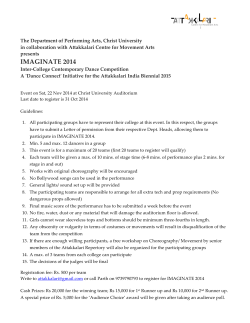
poster
C HARACTER A NIMATION AND E MBODIMENT IN T EACHING C OMPUTATIONAL T HINKING Sophie Jörg, Alison E. Leonard, Sabarish Babu, Kara Gundersen, Dhaval Parmar, Kevin Boggs, Shaundra Bryant Daily I NTRODUCTION M ETHOD Goal: Teach 5th and 6th graders computational thinking and increase the proportion of minorities and, specifically, women in computing. Approach realized in multiple sessions: • first, students alternate between learning elements of choreography and studying concepts from computational thinking • later activities combine both concepts • at the end, the children create their own choreography, program their virtual character, and perform with it Our programming environment: R ESULTS F UTURE W ORK Study: • programming environment Alice • virtual character animated using forward kinematics through commands such as Left_Arm_Bend_Side_Horizontal or Right_Leg_Low_Diag • five-week study at a middle school in the southeastern United States • nine students (8f, 1m, aged 11-12) We are continually testing and improving our approach, the design of our programming interface, and the quality of the character’s motions. Our aim is to allow the creation of a variety of movements such as step, run, leap, hop, or jump with different qualities and styles. For more information and news: Idea: Middle school students learn computational thinking concepts by creating choreography for a virtual character. Movement and programming tasks and activities are alternated and combined. Children learn while at the same time actively using their body. Background: Previous research has shown promising results when applications outside of traditional computer science are involved, and when the writing of syntax is omitted [1]. Our approach is based on embodied pedagogy, where moving one’s body is used to support learning [2]. www.venvi.org R EFERENCES [1] Caitlin Kelleher, Randy Pausch, and Sara Kiesler. Storytelling alice motivates middle school girls to learn computer programming. In Conference on Human Factors in Computing Systems, CHI ’07, pages 1455–1464, 2007. [2] C. Kontra, S. Goldin-Meadow, and S. L. Beilock. Embodied learning across the life span. Topics ˘ S–739, 2012. in Cognitive Science, 4(4):731âA¸ [3] Shaundra B. Daily, Alison E. Leonard, Sophie Jörg, Sabarish Babu, and Kara Gundersen. Dancing alice: Exploring embodied pedagogical strategies for learning computational thinking. In Symp. on Computer Science Education, SIGCSE ’14, pages 91–96, 2014. • inspired by tools such as Alice, Scratch • animations created from motion captured sequences • choreography is created using motion elements such as RightLeg or Attitude (pose where the leg is lifted and the knee bent) and control structures such as Do in order, Do together, or Repeat A CKNOWLEDGMENTS Results: Throughout the study, students repeatedly stood up or moved in front of their computer. They used computational concepts such as loops and computational practices such as testing and debugging. Students liked being able to control the character and wanted to change the appearance of their character and to be able to create more realistic motions [3]. Second study: In a summer camp (2x90 minutes) 57 girls used our method and the programming environment LookingGlass to program the Cha Cha Slide in two groups, one performing choreography the other generic warm-up motions instead. Students enjoyed learning with our approach but there were no significant differences in the performances of the two groups in our pre- and post computational concept tests. This material is based in part upon work supported by the National Science Foundation under Grant Number 1344228. Any opinions, findings, and conclusions or recommendations expressed in this material are those of the author(s) and do not necessarily reflect the views of the National Science Foundation.
© Copyright 2025










